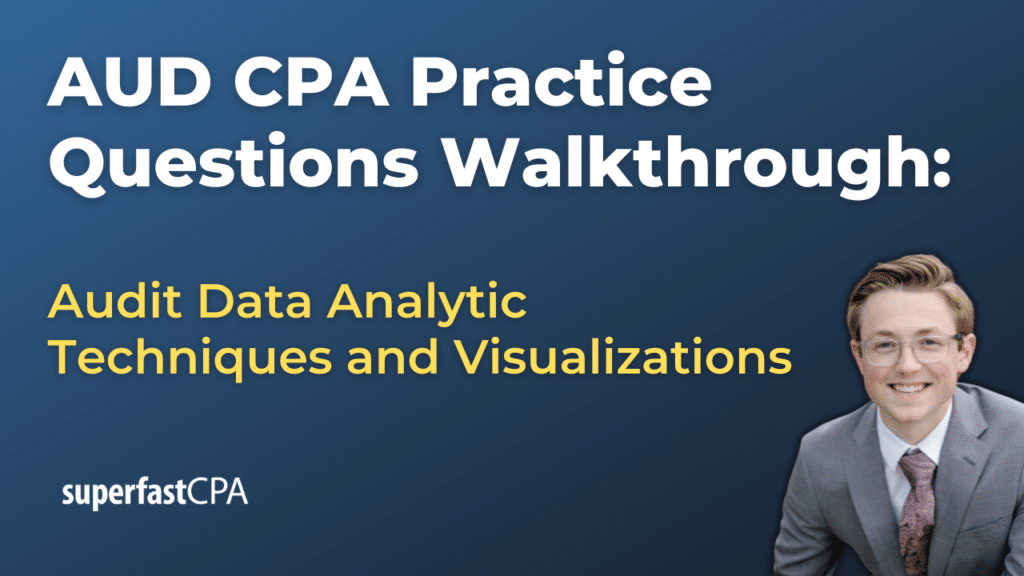In this video, we walk through 5 AUD practice questions teaching about audit data analytic techniques and visualizations. These questions are from AUD content area 3 on the AICPA CPA exam blueprints: Performing Further Procedures and Obtaining Evidence
The best way to use this video is to pause each time we get to a new question in the video, and then make your own attempt at the question before watching us go through it.
Also be sure to watch one of our free webinars on the 6 “key ingredients” to an extremely effective & efficient CPA study process here…
Audit Data Analytic Techniques and Visualizations
Audit data analytics is transforming the way auditors assess financial information. By leveraging various analytical techniques and outputs, auditors can efficiently identify trends, relationships, and anomalies in financial data. This approach enhances risk assessment, fraud detection, and overall audit effectiveness.
Key Types of Audit Data Analytics
Audit data analytics is typically categorized into four types:
- Descriptive Analytics: This type focuses on summarizing past data to provide insights into what has already happened. Common examples include:
- An aging report of accounts receivable to identify overdue payments.
- A summary of expense categories over a fiscal year.
- Diagnostic Analytics: This technique explains the reasons behind trends or anomalies in data. It helps auditors understand why financial changes occurred. Examples include:
- Variance analysis comparing budgeted versus actual expenses to identify unexpected deviations.
- Investigation of irregular journal entries to detect potential fraud.
- Predictive Analytics: Using historical data and statistical models, predictive analytics forecasts future outcomes. Examples include:
- Modeling the likelihood of loan defaults based on past payment behavior.
- Using trend analysis to anticipate future revenue growth or declines.
- Prescriptive Analytics: This approach suggests actionable steps based on data insights. It helps auditors recommend strategies to mitigate risks or improve financial processes. Examples include:
- Advising a company to automate inventory replenishment to prevent stock shortages.
- Recommending tighter internal controls based on historical fraud patterns.
Using Data Visualization for Audit Insights
A key component of audit data analytics is presenting findings in a meaningful way. Different types of visualizations help auditors interpret complex datasets:
- Bar Charts: Useful for comparing financial metrics over time, such as revenue growth across different quarters.
- Line Charts: Ideal for identifying trends, like fluctuating sales figures throughout a fiscal year.
- Scatter Plots: Helpful for detecting correlations, such as the relationship between advertising expenses and sales revenue.
- Pie Charts: Best for showing proportions, such as the percentage breakdown of total expenses by category.
- Bullet Graphs: Effective for benchmarking financial performance against set targets.
Identifying Relationships, Trends, and Notable Items
Auditors must analyze data patterns to detect irregularities and potential risk areas. Some key areas of focus include:
- Correlation Analysis: Identifying relationships between financial variables, such as sales and marketing expenses.
- Period-over-Period Comparisons: Examining revenue or expense trends across different time periods to flag unusual fluctuations.
- Outlier Detection: Spotting unusual transactions, such as significantly large journal entries that may indicate fraud.
Structured vs. Unstructured Data in Audits
Understanding data types is essential for effective audit analytics:
- Structured Data: Highly organized, numerical data stored in databases or spreadsheets (e.g., general ledger entries, financial statements).
- Unstructured Data: Text-based or non-numeric data that requires advanced processing (e.g., customer complaints, emails related to financial transactions).
Applying Audit Analytics to Real-World Scenarios
Auditors use these techniques to improve audit quality in various ways:
- Fraud Detection: Identifying suspicious transactions through anomaly detection and text analysis of emails.
- Risk Assessment: Using predictive analytics to assess the likelihood of material misstatements.
- Efficiency Improvement: Automating repetitive audit tasks, such as matching transactions against external data sources.
As audit data analytics continues to evolve, auditors who master these techniques will enhance their ability to provide deeper financial insights and strengthen the integrity of financial reporting.














